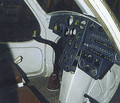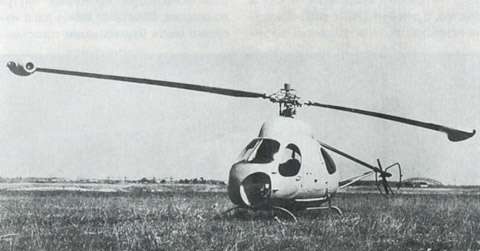|
|
Experimental 4-seat light helicopter with egg-shaped fuselage, skid u/c, thin triangulated tail boom structure, powered by two AI-7 tip-mounted ramjets. One Prot. FF 1959. R.Simpson "Airlife's Helicopter and Rotorcraft", 1998
Few details available of this experimental tip-drive helicopter completed 1959. Pilot and three passengers in stressed-skin nacelle with three doors, tail on tubular boom, skid landing gear and kerosene tank in roof. All-metal blades (related to final Mi-1 but shorter) carrying subsonic tip ramjets. Hub of design unlike other Mil helicopters. Inclined drive shaft to tail rotor. Believed never flew with more than pilot on board, and never publicized. Bill Gunston "The Osprey's Encyclopedia of Russian Aircraft", 2000
 |
Mil V-7
|
 |
Mil V-7 helicopter model
|
 |
V-7 test batch assembly
|
 |
V-7 engine starting
|
 |
V-7 engine starting
|
 |
V-7 experimental helicopter in the Soviet Air Force museum in Monino
|
 |
V-7 experimental helicopter in the Soviet Air Force museum in Monino
|
 |
V-7 tail rotor
|
 |
V-7 experimental helicopter in the Soviet Air Force museum in Monino
|
| Technical data for Mil V-7
Engine: 2 x AI-7,
rotor diameter: 11.6m,
loaded weight: 835kg,
empty weight: 730kg
|
| lxbfYeaa, e-mail, 14.03.2024 | reply |
20 | | lxbfYeaa, e-mail, 14.03.2024 | reply |
20 | | Rocketman, e-mail, 22.08.2020 | reply |
I can't understand why it would need a tail rotor if the jet engines were on the tip of the rotors. That should make it unnecessary since there would be no torque affecting the helicopter. |
| Charles Glazebrook, e-mail, 30.07.2009 | reply |
I am currently building a similar type of Helicopter.A 5h.p. Generator powers the motors that turn props at wingtips.Similar to the jet tip.Contacts similar to a car horn allow the wing rotate and tilt.I have pictures of the nearly complete prototype but don"t know how to send them to you. Charlie |
| T.Kiel, e-mail, 18.04.2009 | reply |
I have got an enquiry concerning some photos of the Mil V-7 from the Monino-Museum for a scale model project.
Please help me. |
|
| |
|
Do you have any comments ?
|
| 
Virtual Aircraft Museum

All the World's Rotorcraft
|






 Rocketman
Rocketman

20
reply